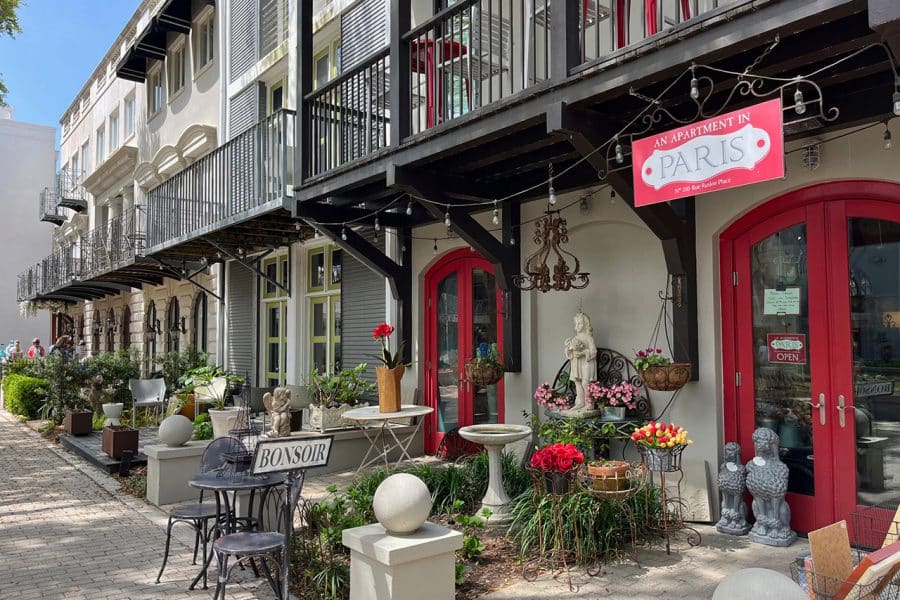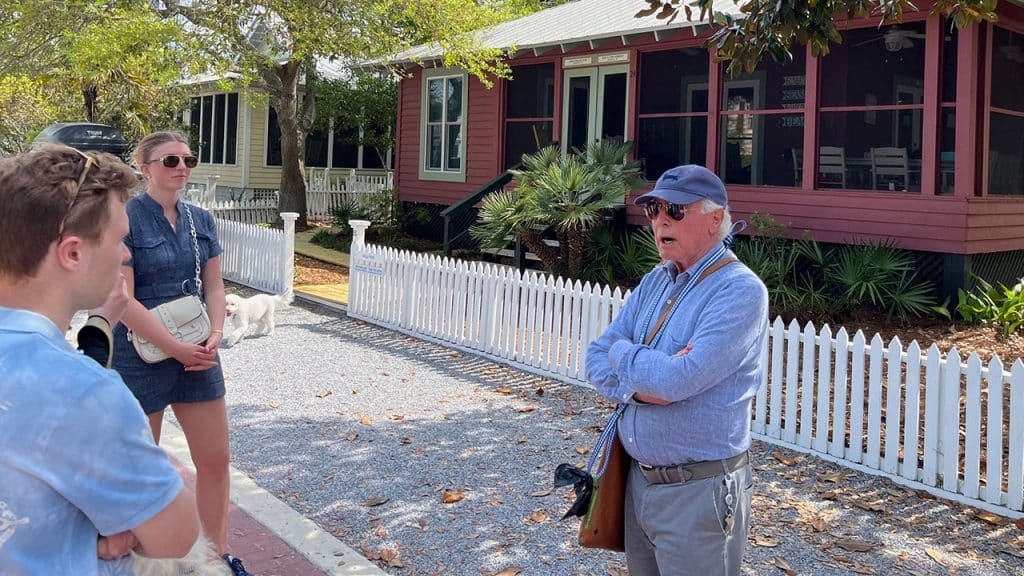
Touring Seaside with new urbanism pioneer Robert Davis
On a sunny spring morning, Robert Davis coasted to a stop and dismounted his vintage bicycle. Wearing a ballcap and a messenger bag over a shoulder, you wouldn’t know Davis is the founder of Seaside, Florida, arguably one of America’s most influential residential developments in the past half century.
With his fluffy white dog Gracie ambling alongside, the spry 81-year-old gave a walking tour of Seaside for a group that included graduate students enrolled in UF’s Master of Science in Real Estate program.
As we strolled, Davis provided a history lesson and an insider’s view of Seaside, widely known as the birthplace of new urbanism and the model for later communities such as Rosemary Beach and Disney’s Celebration. Conceived in reaction to the anonymity of conventional suburban subdivisions, Davis explained the essentials of Seaside: its narrow gridded streets, bungalows with front porches and deep roof overhangs, alleyways, and a town center surrounded by retail shops. No wonder “The Truman Show” was filmed here to stand in for a picture-perfect town.
Davis’ vision traces to the early 1980s after he inherited 80 acres on the Gulf of Mexico. Wanting to recreate a walkable community like old-fashioned neighborhoods he recalled from his youth, he hired Andres Duany and Elizabeth Plater-Zyberk, a young architect team from Miami. Davis was averse to taking on debt after having had a brush with failure of a real estate development in Miami. So he built the unincorporated community incrementally, initially selling 20 to 30 lots a year and reinvesting the profits into infrastructure. A series of homeowners associations were created over the years to keep up community standards. Early decisions produced financial windfalls, such as his holding onto Gulf-frontage lots that now sell for millions of dollars. His development company also retained the right to manage and reap a share of the revenues of homes rented in a resort town where the majority of residents live only part-time.

His inspirations
Something of a historian of traditional neighborhood developments, Davis cited many people and places that have inspired the concept of Seaside. He noted a mural on a large commercial building in central Seaside depicting Vincent Scully, the late Yale professor whose urban design ideas influenced his former students Duany and Plater-Zyberk and many other planners. He pointed out a house designed by architect Léon Krier, who is most famous for later designing Poundbury, the walkable English town championed by Prince Charles, now King of England. Davis highlighted elements borrowed from Belgravia and Mayfair, London neighborhoods built in the 1800s that he believes are among the most desirable urban residential areas in the world. He noted these influences while explaining the design of Ruskin Place, a greenspace surrounded by townhouses, an outdoor café and an antique shop. At one end of the square is one of the town’s tallest structures, the steeply pitched roof of a white chapel designed by renowned Vero Beach architect Scott Merrill.
Davis said some initial ideas are admittedly laughable and hopelessly nostalgic for a slower pace of life. Dogs with pedigrees needed to be on leashes, but mutts could roam free. Conceived during the late stage of the energy crisis, he envisioned outdoor showers and homeowners eschewing dryers for clotheslines. They considered banning TVs in rental homes to improve the experience of families to enjoy the beach, play games and tell family stories. “We were persuaded by our real estate folks who were running the vacation rental program that this was a completely Sisyphean task, and we would never succeed at it — so we gave up on that,” he said.
Other unusual features were retained, such as virtually outlawing grass except for the amphitheater and a few other public spaces. All existing vegetation was required to be left in place except for the building footprint. Where vegetation was disturbed, it was replaced with native plants.
Having become something of a philosopher and critic, he provided a dim assessment of regulatory and societal changes that make developing such a walkable mixed-use community a bigger challenge now. These include the rise of the NIMBY (not-in-my-backyard) movement and restrictions on development that have increased the length of time and the cost of building. “When we started submitting plans there was no zoning code, there was no building department and there was no planning department. That’s why we could get building permits in two days instead of spending months,” he said.
Another big hurdle: the impatience of financiers. Real estate investment trusts (REITs) and private investors don’t have the patience to adhere to a slower growth strategy that made Seaside successful. He said he wouldn’t have been able to keep a straight face if he told investors and bankers in the early ‘80s that the value of the million-dollar property would appreciate several hundred times — but it’d probably take a couple decades. The developer said real estate investors today use what seem to him “divinely ordained” measurements — internal rates of return and discounted cash flows — to assess real estate investments. The problem with these tools, he said, is they are almost meaningless in measuring real estate investments longer than five or six years. Seaside blazed a different path to success. “If you do it carefully and slowly — and the key to this place is slow, modest increments of growth — we are pretty confident that nothing will put us under during the next downturn,” he said.
Charles Boisseau is editor of Due Diligence.
See related story, Returns to new urbanism.
Related Stories
Sign up for our mailing list
For the media
Looking for an expert or have an inquiry?
Submit your news
Contact us
Follow us on social
@ufwarrington | #BusinessGators


